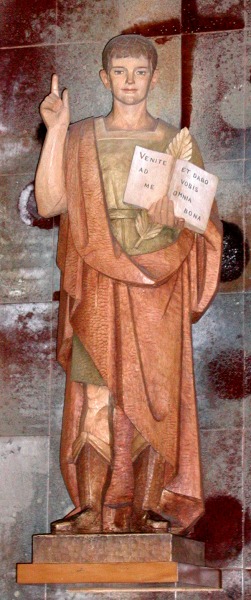ST. PANCRACE BEFORE THE EMPEROR DIOCLETIaN
Finally Denis died in the country, and Pancrace was taken and presented to Cæsar. And then was Pancrace about fourteen years of age. To whom the emperor Diocletian said: "My little child, I warn and counsel thee that thou advise thee well, to the end that thou die not an evil death, for as a child thou art lightly deceived; and because thou art noble of blood and of lineage, and son of one my right dear friend, I pray thee that thou leave this madness that thou hast emprised, undertaken and that I may have thee with me as my son."To whom Pancrace answered: "If I be a child of body yet mine heart is old, and by the virtue power of my lord Jesu Christ your threatening and menaces make me no more to move than doth the painting that I see upon the wall; and these gods that thou wouldest that I should worship be but deceivers of creatures and have been as germains brothers in fornications made against God their creator, and have not spared kin ne nor other. other people And if thou hadst knowledge that thy servants were such, thou shouldst command that they should be slain, and I much marvel that ye adore such gods."
When the emperor heard this child thus speak he doubted feared to be overcome of by him, and commanded that his head should be smitten off, and so he was martyred about the year of our Lord two hundred and eighty-five, whose body a worshipful lady named Cocovilla, which was of the senate, with great diligence buried honorably. And of him said Gregory of Tours, doctor: That if there be a man that will make a false oath in the place of his sepulchre, tofore or before he come to the chancel the part of a church near the altar, reserved for the clergy and choir, and typically separated from the nave by steps or a screen of the quire choir (the part of medieval churches where the clergy sit) he shall be travailed with an evil spirit and out of his mind, or he shall fall on the pavement all dead.
OATHS ON THE RELICS OF ST. PANCRACE
It happed on a time that there was a great altercation between two men, and the judge wist knew not who had wrong. And for the jealousy of solicitude for justice that he had, he brought them both unto the altar of S. Peter for to swear, praying the apostle that he would declare who had right. And when he that had wrong had sworn and had none harm, the judge, that knew the malice of him, said all on high: This old Peter here is either over merciful or he is propitious to this young man, but let us go to Pancrace and demand we of him the truth; and when they came to the sepulchre, he that was culpable sware, swore and stretched forth his hand, but he might could not withdraw his hand to him, himself and anon immediately after he died there, and therefore unto this day of much people it is used customary that for great and notable causes men make their oaths upon the relics of S. Pancrace.
Golden Legend Table of Contents
Christian Iconography Home Page

St. Pancras's is usually pictured as a young boy dressed like this pointing to Heaven. (See the description page for this image and the page explaining the iconography of images of this saint.)
VORAGINE'S ETYMOLOGY FOR THE NAME [SAINT'S NAME]
Pancrace is said of pan, that is as much to say as all, and gratus and citius, which is as much to say as courteous in his young age. Or otherwise, as it is said in the book called glossarium, pancras is said rapine, or pancras is, subject to beatings and torments. Pancrace is also said of divers colours; and so it appeared by him: he used rapine in ravishing by his exhortation the prey of caitiffs misbelieving, in bringing them to the faith. He was also subject to beatings and torments in suffering them, also in divers colours and full of all virtues.
This text was taken from the Internet Medieval Source Book. E-text © by Paul Halsall. Annotations, formatting, and added rubrics by Richard Stracke. Permission is granted for electronic copying, distribution in print form for educational purposes and personal use. If you do reduplicate the document, indicate the sources. No permission is granted for commercial use.